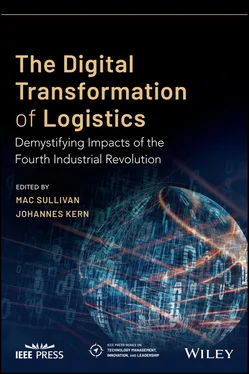Center of Excellence as a Leader of RPA
As operations in developing countries like China, India, the Philippines, or Malaysia grew for many manufacturing companies and the governments of these countries started favorable IT investment incentives, logistics companies also began to set up outsourcing centers. These centers are heavily reliant on labor cost arbitrage as the key decreased input would be manpower. Considering that the abovementioned countries become more competitive in terms of available skills, while labor costs are increasing, automation and specifically RPA are opening up the argument that BPO itself could become redundant (Casale 2014). To do that, RPA must mitigate not only the cost component but also technical complexities that may not be apparently ready. Economies of scale are a consideration in evaluating RPA as well as BPO practices as the initial cost of developing or training a bot can be more than training a human to the same task. BPO providers who have the skillset of process mining, mapping, and relocating might be the perfect leaders of implementing RPA, especially for their existing clients (Hallikainen et al. 2018). When considering a project team to look at RPA, involving your BPO team may be a path to consider.
RPA: Hype or Realistic Solution
The Facts
As with many of the Fourth Industrial Revolution technologies mentioned in this book, RPA has become a trending topic in the world of supply chain and logistics, and there are many speculations about wide adoption in the following years. The Chartered Institute of Procurement and Supply predicted that by 2019, there would be 72% of all companies using RPA to reduce costs and transaction times and increase levels of productivity and compliance (Deckard 2018). However, just as with other discussed technologies both present and past like Blockchain and RFID, companies are finding it much more difficult to implement it than originally expected. Gartner reports that RPA tools sit at the “peak of inflated expectations” in its hype cycle (Kerremans 2018). Fersht and Snowdan (2017) report that the RPA software market and RPA services expanded by 42% from 2017 to 2018 and are predicted to grow by 94% by 2021. Growth in RPA is not necessarily a question of when but more a question of how fast we will see it come to fruition.
The hype surrounding RPA has been around for the past five years though, and it warrants looking at past predictions to see where we are now. Transparency Market Research (2015) claimed that the IT RPA market would reach $4.98 billion by 2020. Kenneth Research (2019) reported that by 2026, the RPA market would be $8.8 billion. However, Grand View Research (2018) shows that in 2018, the total RPA market size was around $600 million well short of the progress that had been anticipated. Although until this point RPA has been looking more like hype than reality, we believe that this technology is worth further investigation.
Rote, Repetitive Tasks Ripe for Automation
If you are still on board to continue examining a task that you would prefer not to do yourself or have your local staff to handle, there are still a few more steps to identify whether it is the right candidate for RPA. Traditional process automation in the BPM sense where systems are configured to interact with each other requires many of the same cases of a task to be done in a short period to justify the costly investment. RPA, on the other hand, offers a cheaper and quicker implementation to target tasks that do have repetition, but a small amount of variation spread out over a longer time but still have enough scale to consider automation (van der Aalst et al. 2018). Insurance and credit card companies have utilized process automation as they had a large pool of claims and payments that were often being handled in very similar ways.
Jesuthasan and Boudreau (2018) explain that there are three characteristics to categorize the components of jobs to identify if they are suitable for automation. The first characteristic of the task is looking at whether it is repetitive or variable. Repetitive tasks are those that are done the same way every time, such as credit application, which pulls a report using the same customer data on each application, as opposed to a variable task, like human resource consultants whose work will vary greatly for each customer. The second characteristic is whether a task is independent or interactive. Independent work can be done by one person without interacting with others like generating accounting statements as opposed to collaborative work that requires communication skills like would be needed by an employee working for a call center. The last characteristic of a task ripe for automation is whether it is physical or mental work. This distinction is somewhat obvious: physical work requires dexterity and strength, whereas mental work requires cognitive ability. The tasks that are best fit for RPA and other forms of automation are those that are repetitive, independent, and mental.
Fung (2014) defines his criteria for potential RPA tasks as follows: (i) having low cognitive needs in terms of subjectivity or interpretation needs, (ii) being large in volume, (iii) needing to move between different applications, (iv) having small amounts of variability and exceptions, and (v) a task that has demonstrated human entry errors that have caused issues in the past. Since most RPA bots lack the cognitive capabilities of AI and machine learning (ML) algorithms, it won't be able to handle tasks with a large amount of variance, and due to it being software, it won't be able to complete any physical work (Jesuthsan and Boudreau 2019). An RPA bot is programmed to perform actions on the computer in the same way that a human would by navigating interfaces through clicking and typing. The bot is not smart in the sense that it knows what information it needs to pull or what button it needs to click; it simply knows where the button and information are and when the interaction should happen. Since the bot functions using location data to navigate elements of the interface, any changes to the interface or the appearance of the page will cripple the bot's functionality.
Process Considerations of Implementing RPA
While the initial capital expenditure in having the bot created by one of the 20+ RPA companies is continuing to drop, the return on investment (ROI) for that investment is still unclear for small‐ to medium‐sized companies who do not have the scale to take advantage of automating these rote and repetitive tasks. Companies need to carefully identify certain processes that have a rule‐based structure and are draining a considerable amount of resources (Lowers et al. 2016). Variability in the types of processes that logistics companies could automate and the 12–15 players included in almost every international shipment make it very difficult to map out how many of the tasks need to be accomplished. System errors, changes in forms, variability in documentation types, etc. all create the need for RPA tools to have the ability to “learn” like a human would. However, the tools are not developed to that level yet (van der Aalst et al. 2018). According to an article published by Inbound Logistics, automation not only can help processes to run more smoothly but also enables companies to monitor processes over time in hopes of that continuous improvement goal that many large logistics companies so proudly advertise. What may not be abundantly clear is that the “monitoring” of tasks in terms of an RPA bot has a cost associated with it, as you have to have trained staff or outside consultants available to ensure the continuity of the process being done correctly. Not only is there a cost to monitor bots, but also the more significant investment is also in process mining, process mapping, and training the bot to do the work.
Читать дальше












